





Coral trees include well over 100 species of some of the most beautiful flowering trees originating from all around the globe. The following is an introduction to some of the most commonly grown species.
To me, one of the most beautiful of all the flowers that do well in my climate are those of the coral trees and shrubs. Erythrina is a large genus with over 100 species, most which are tropical or subtropical. However many of these do quite well in my temperate climate of southern California and I have seen dozens of species growing here in various gardens and parks. They make excellent companion trees to the other plants I like to grow (palms, cycads and succulents). This article will serve as an introduction to this highly ornamental genus of trees and shrubs.
Erythrina is a truly global tropical genus with at least one species are more existing on every tropical continent around the world, and on dozens of islands in between. Even the Galapagos has its own species, as do most of the Caribbean Islands. Madagascar has several and Australia has one as well. The name Coral Tree is somewhat misleading as very few species of Erythrina actually have what one would call coral-colored flowers. Red is by far the most common colors though some species have pink, orange, white, green, yellow and even coral flowers. The plants themselves also come in a large variety of appearances, from massive giants to small, shrubby, sparsely branched plants only several feet tall. Most are deciduous trees. Many have spines. As for cold tolerance, only a few can tolerate much frost (Erythrina crista-galli and the U.S. native species, Erythrina herbacea. However at least another dozen or more do tolerate a modicum of frost as they are growing in areas of Los Angeles that get a bit of frost almost every year. The hard, colorful seeds, which fill the typical legume seed pods of this genus are reportedly quite toxic, so before one plants one in their yard, those that have pets might want to place in far from harm's way.
But it's the flowers themselves that are the main attraction with this species. They are such a brilliant color and amazing shape, though many species have different shaped flowers. Some have remarkable radial symmetry, some grow sparsely along a flower spike while others have large, clustered flowers that look like horns of plenty, and still others have almost fluorescently brilliant rainbow colors that are almost hard to look at. All the flowers are attractive to hummingbirds, so this should be a tree on the lists of those attempting to grow a garden that will attract such birds.
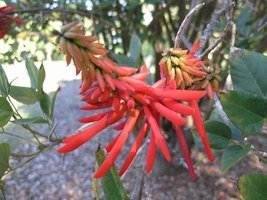
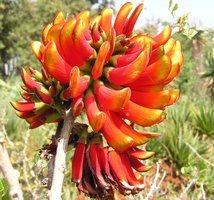
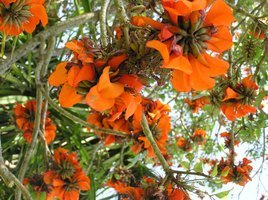
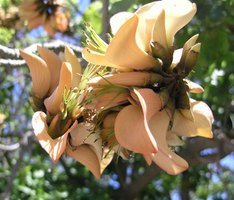
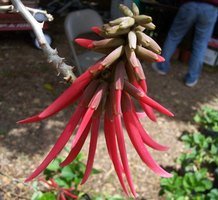
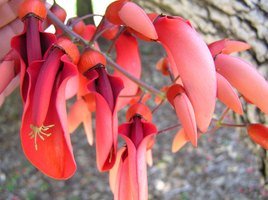
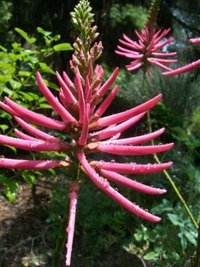
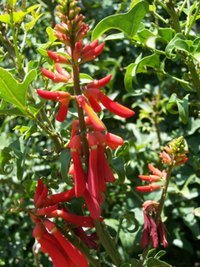
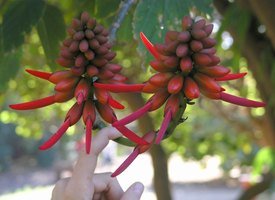
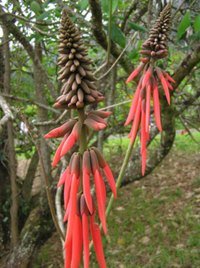
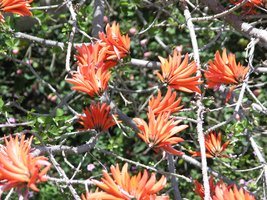
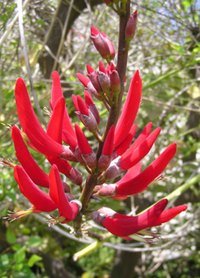
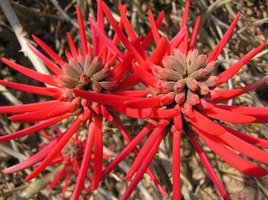
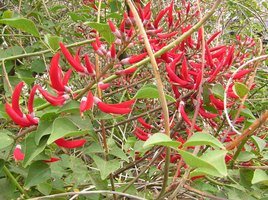
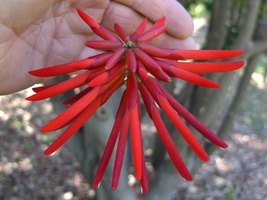

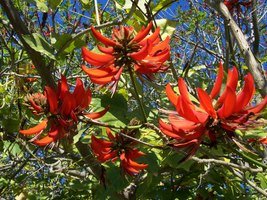
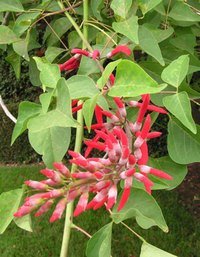
Most Erythrinas can be grown easily from seed except for the hybrid species. All seem reportedly straightforward in terms of propagating from hardwood cuttings and airlayering as well. Some species also seem to be grown readily from new growth cuttings (especially Erythrina crista-gali).
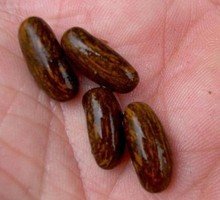
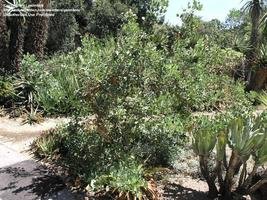 Erythrina crista-gali and unknown seed
Erythrina crista-gali and unknown seed
The following are some of the more commonly grown Eryrthrina species in cultivation, at least from my experiences. The reader may have become more familiar with several other species in other various parts of the country, particularly Hawaii or south Florida where other more tropical species might perform better.
Erythrina acanthocarpa (Tambookie Thorn): though perhaps fairly atypical for the genus, this is one of my favorite species of Erythrina thanks to its banded, brilliantly bi-colored flowers. Unfortunately these flowers only last a few weeks or so, and the rest of the year the plant is not much to look at. It is a short (up to six feet tall) shrubby native of South Africa that flowers in late spring to early summer, but looks spindly and sparse the rest of the year. The leaves of this plant are small, ovoid and have hooked thorns on the back making it a poor choice for growing along paths. It is, like most Coral Trees, deciduous much of the year so it looks like a dead spindly bush from fall through winter. However it does make an interesting potted plant having a large, succulent underground caudex that can be raised up a bit for interest. This is an excellent cactus and succulent garden companion. It is a frost hardy species, but not much below the high 20s F.)
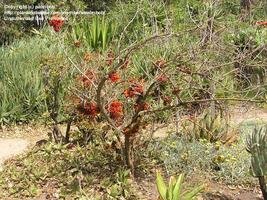

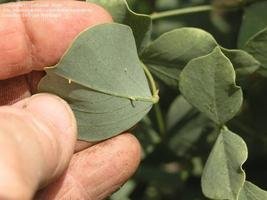
plant in spring (left) plant in summer (middle) leaves showing hooks on underside
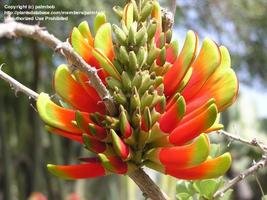
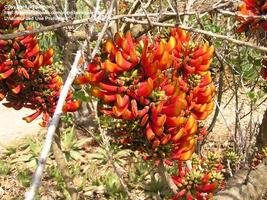
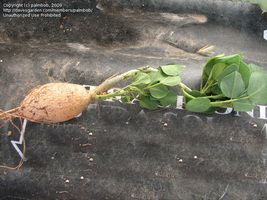
typical flower of Erythrina acanthocarpa flowers in late winter or early spring caudiciform root of seedling
Erythrina x bidwillii (Fireman's Cap or Shrub Coral Tree): This is a hybrid species from crossing Erythrina crista-galli and Erythrina herbacea (an South American species with a North American species) that has excellent cold tolerance (down to around 20F). The flowers are scarlet and bloom end of spring, much of the summer and sometimes into fall. The flowers form spread out along a flower spike. Plants grow up to about fifteen feet tall. Since these are sterile hybrids, they produce no seeds. From my understanding all propagation is from hardwood cuttings.
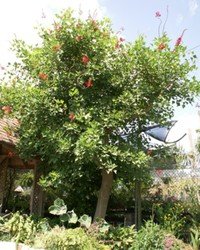
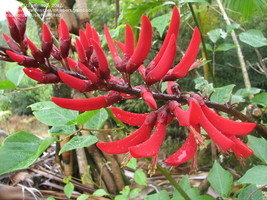
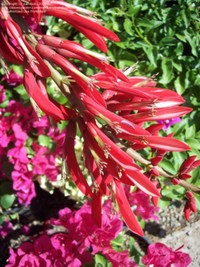
Erythrina x bidwillii tree (photo Elphaba) and flower (middle and right)
Erythrina caffra or E. fusca (Kaffirboom Coral Tree): This is a commonly grown, massive landscape tree in Southern California. Most nurseries and botanical gardens refer to is a Erythrina caffer, but I understand the correct name is fusca... however since almost no one refers to it by its correct name, I list Erythrina caffra here as the first name. Trees grown in moist, fertile and well draining soil can grow up to sixty feet in height, but most trees top out around forty feet. The flowers start appearing in winter and grow through much of the spring, about the time the leaves start appearing. By summer the trees are all leaves and no flowers. A mature tree in full flower is one of the most spectacular sights with large numbers of brilliant orange flower clusters in tight, radial patterns in a large, majestic tree with naked, twisted limbs. There are pale-peach flowering forms, but the normal flower color is a deep orange. It is an excellent specimen tree but requires a lot of room. This species has some fairly good frost hardiness at least down into the high 20Fs. Seeds are brilliant red and easy to germinate.
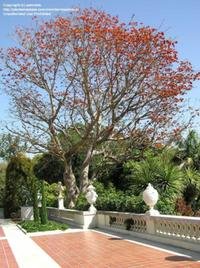
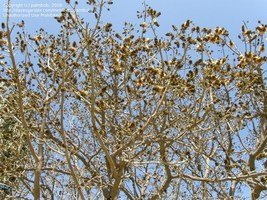 Erythrina caffras (orange on left, peach on right)
Erythrina caffras (orange on left, peach on right)
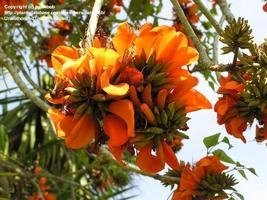
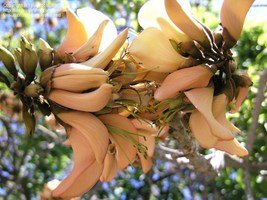

the 'common' orange colored flowers in first two photos much rarer peach colored flowers
Erythrina chiapasana (Pipal): This Mexican species is a relatively small tree, deciduous in winters with flowers showing up mid-winter and vanishing by late spring about when leaves start to recur (in some climates there is some overlap). Flowers are scarlet conical clusters of long, tubular petals up to three inches long. This is a fairly rare species in cultivation, but is an extremely drought tolerant one and a good companion tree for succulents and cacti. Cold hardiness is barely below freezing.
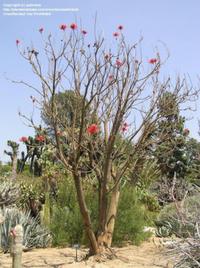
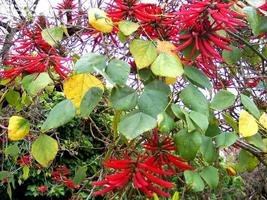
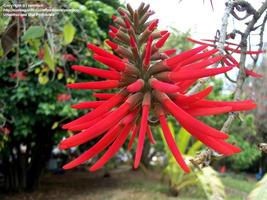
Erythrina chiapasana in cactus garden southern California (left); spring flowers and leaves at same time (middle) and flower (right)
Erythrina coralloides (Naked Coral Tree): This Mexican and Arizona native is a low growing, horizontally oriented tree with a massive, hard trunk and hooks along the branches (careful!). Flowers are made up of tubular scarlet structures radiating out along the tip of a branch in an overall squat, conical shape, and occur in later winter through spring. Some forms have both white and red flowers and are spectacular spring trees when in full bloom. In summers the trees are thickly leaves while in winter they are completely ‘naked'. Cold hardiness seems to be down into the high to mid 20Fs though some claim this species can tolerate freezing temperatures down to 20F.
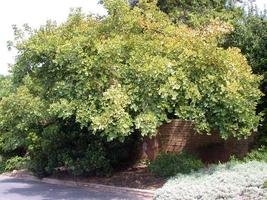
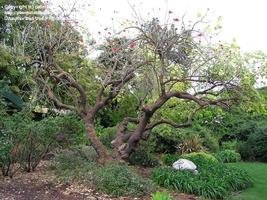
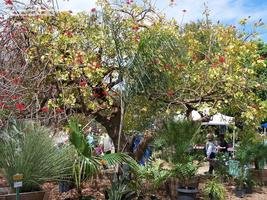
Erythrina collaroides in summer (left), late fall/winter (middle) and spring when it has both flowers and leaves for a short time (right)
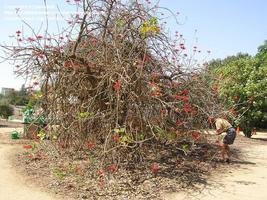
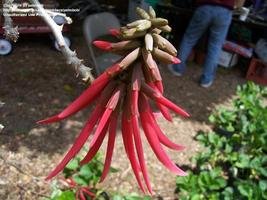
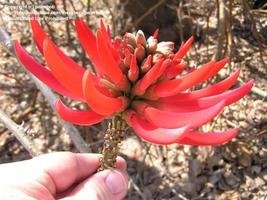
Tree in mid to late winter when it only has flowers (very thorny tree, so careful) (left); two photos of flowers of Erythrina collaroides
Erythrina crista-galli (Cockspur, Fireman's Cap Tree, Brazilian Coral Tree): As the same suggests, this is a South American native with surprisingly good cold tolerance (down to about 20F). Flowers consist of single beak-shaped red-pink to salmon colored structures in large, non-geometric clusters along several feet of a branch end. The beak-shaped flowers eventually open up to an ovoid to heart-shaped carpal with a tubular projection from the non-pointed end, and are quite ornamental. Seeds are multicolored and very easy to germinate. As are most Coral Trees, this species is quite drought tolerant. These are low growing very densely branched trees that are somewhat unattractive when deciduous in winters.
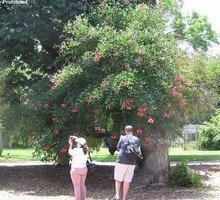
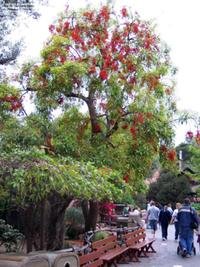 Several Erythrina crista-galis in southern California
Several Erythrina crista-galis in southern California
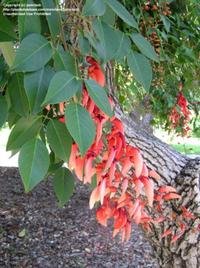
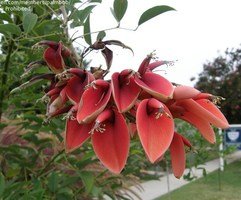
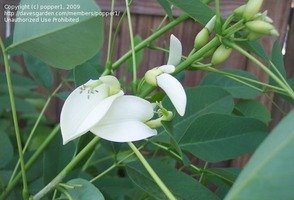
Flowers of Erythrina crista-gali (photo of right of rare white form by popper1)
Erythrina flabelliformis (Southwestern Coral Bean): this U.S. and Mexican native varies in appearance depending on where it is growing, with the desert US plants barely growing any larger than small shrubs, but getting up to thirty feet tall in the warmer, moister Mexican climates. Flowers are radially symmetrical with three to four inch tubular scarlet petals arranged in an overall conical silhouette.
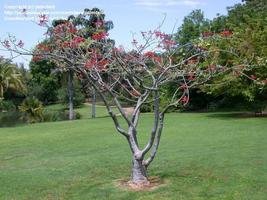
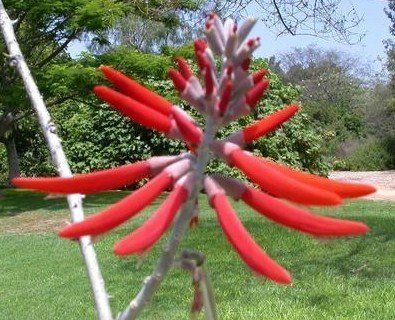
Erythrina flabelliformis in southern California- normally a four to six foot shrub in the US, this tree is unusually large (left); flower (right)
Erythrina herbacea (Cherokee Bean, Coral Bean): This is an eastern U.S. native shrub up to about 15 feet tall, but usually shorter in colder climates (will even freeze to the ground and grow back at the low end of its cold tolerance range). This is probably the most cold tolerant (zone 7b-8a) of the Erythrina, and also the most commonly grown. Flowers form in a lose radial pattern and are made up of brilliantly red or deep pink flattened, slightly curved tubes in late spring to very early summer. Leaves have a unique bulge near their base which sets this plant apart from other Erythrina. It is a very popular hummingbird and butterfly attractor. This species is not known for its drought hardiness and seems to prefer regular watering most of the year.
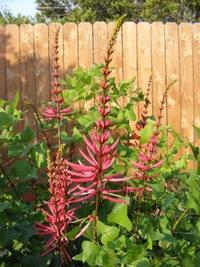
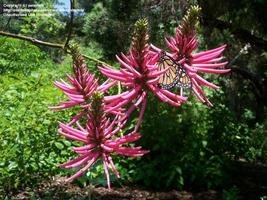
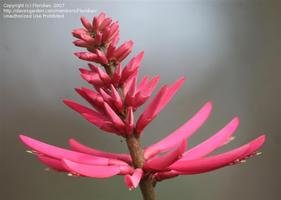
Flowers of Erythrina herbacea (super pink ones center photo from Huntington Gardens, southern California); left photo arroyophyte; right photo Floridian
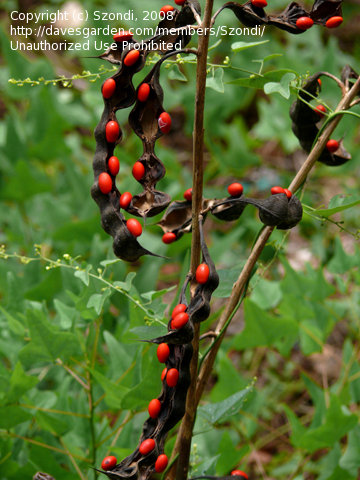 seed and pods of Erythrina herbacea (photo Szondi)
seed and pods of Erythrina herbacea (photo Szondi)
Erythrina humeana (Dwarf Coral Tree, Natal Coral Tree): This smaller African shrub/tree is one of the only Coral Tree discussed here that blooms in the late summer to fall. Inflorescences are made up of a dense cluster of upright orange to deep orange-red flowers that form a brilliant, slightly curved, narrow conical shape. The flowers look a bit like large, red-orange flying insects all flying upwards. This species tolerates some frost down to about the mid 20Fs.
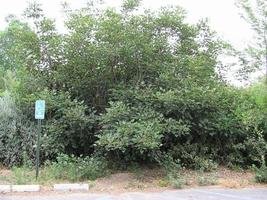
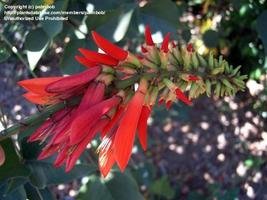
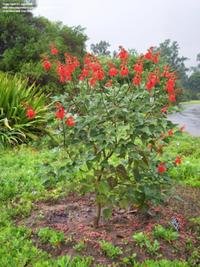
Erythrina humeana in late spring (left); flower close up in fall (center); young plant mid fall (right)
Erythrina latissima (Broad-Leaf Coral Tree): From South Africa, this short tree (eight to fifteen feet) has several unique characteristics. The bark of this species is very corky and all new growth is wooly. Even the perfectly flat, stiff, nearly circular, large leaves have a prominent fuzzy layer on them, which eventually wears away leaving the leaves a drab green color. Flowers are borne in very tight clusters in late winter to early spring and are a deep red to red-orange.
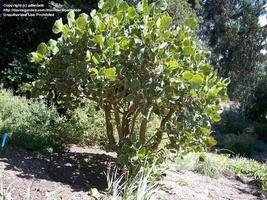
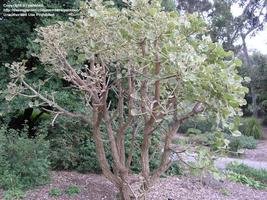
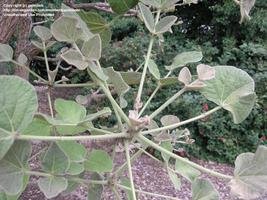
Erythrina latissima in summer (left) and spring with fuzzy new growth (center and right)
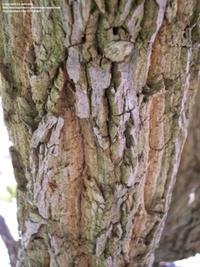
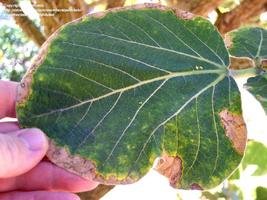 Erythrina latissima corky bark, and flat, large leaf
Erythrina latissima corky bark, and flat, large leaf
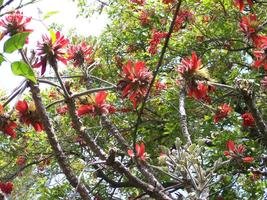
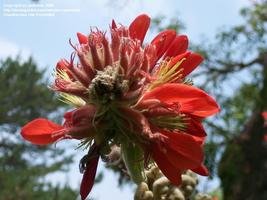 Erythrina latissima flowers in spring
Erythrina latissima flowers in spring
Erythrina lysistemon (Common Coral Tree): Also originating from South Africa, this large species looks very similar to Eyrthrina caffra (fusca) except its flowers are tight clusters of curved, conical petals that make the inflorescences look like deep orange to red-orange shuttlecocks. This species tolerates some minimal frost down to the high 20Fs.
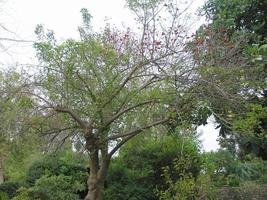
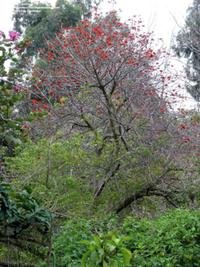
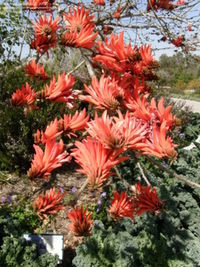
Erythrina lysistemon in summer (left), winter (center) and spring flowers (right)
Erythrina sandwicensis (Wiliwili, Hawaiian Coral Tree): This is a relatively tropical species, hardly grown at all in southern California, but a commonly grown native in Hawaii, where it is one of the few deciduous Hawaiian native trees. It also is unusual in losing its leaves in the summer unlike most Erythrinas that lose their leaves in winter. Flowering is also off a bit, occuring in summer after leaves are lost. Flowers are flattened circles of a variety of colors from orange, white, pale green, salmon etc. Trees grow up to thirty five feet or more, but are usually much shorter. For more on Erythrina sandwicensis, go here.
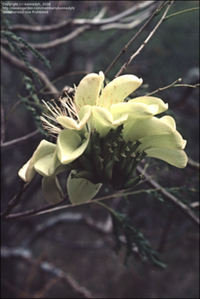
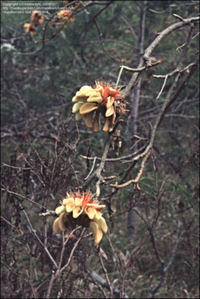 flowers of Erythrina sandwicensis (photos kennedyh)
flowers of Erythrina sandwicensis (photos kennedyh)
Erythrina x sykesii (Australian Coral Tree): The common name is somewhat misleading as it is not a native of any country, but a hybrid that seems to have become naturalized on Australia before it became popular anywhere else. It is presumed to be an Erythrina lysistemon cross, but no one knows with what. This is a larger, vigorously growing tree with beautiful scarlet flowers made up of long, tubular, curved petals in a tight, upward-pointing radial pattern (not terribly unique for this genus, but certainly unlike Erythrina lysistemon). Cold hardiness is good down to the mid 20s, and it seems pretty tolerant of salt-water-laden winds (good tree for coastal warm climates). Propagation is by cuttings only (does not make seeds).
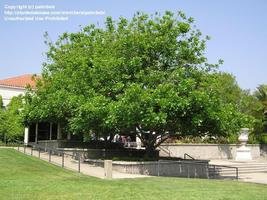
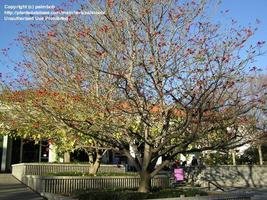
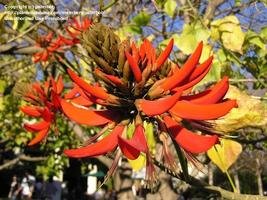
Erythrina x sykesii in summer (left), early spring (center) and flowers (right)
Erythrina variegata (Indian Coral Tree, Tiger's Claw, Sunshine Tree): Native to just about all of tropical Asia and northern Africa (some claim also Australia), this large tree is a very commonly grown tree in cultivation, though not so much in southern California where it is an extremely marginal species. It is grown not only for its brilliant red-orange horn-of-plenty shaped flowers, but for its commonly variegated leaves as well (not all trees have variegated leaves). Flowering is generally in mid to late winter, into spring. There are cultivars that have white to greenish-white leaves, or others that are grown for their unique upright, giant stature and used often as windbreaks in tropical climates. Most forms only grow to fifty to sixty feet, but these upright forms can grow over eighty feet tall. This is an intensely thorny tree, covered with very sharp, hooked brown thorns (hence the name Tiger's Claw).
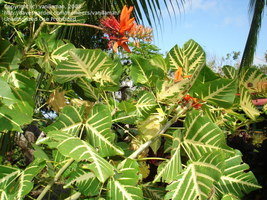
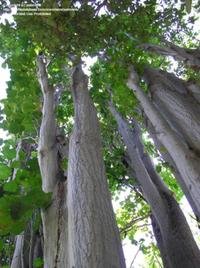
nice variegated leaves of Erythrina variegata (left- photo vanillaman); upright tall cultivar in Hawaii (right)
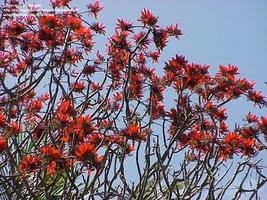
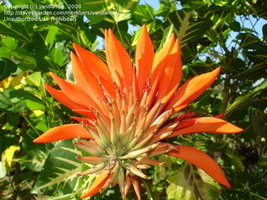
Erythrina variegata flowers (photos einaudi and vanillaman)
There are hundreds of other species of Erythrina and probably all are worthy of growing. However, these seem to be the most commonly grown species above.
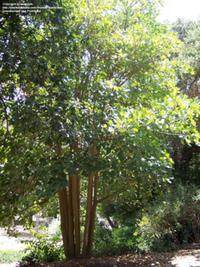
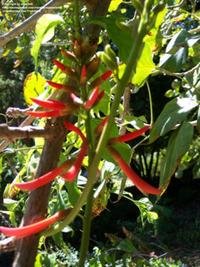 Erythrina chiriquensis in southern California
Erythrina chiriquensis in southern California
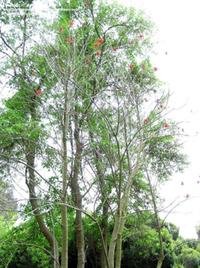
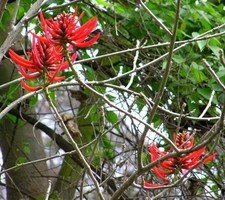 Erythrina americana in southern California
Erythrina americana in southern California
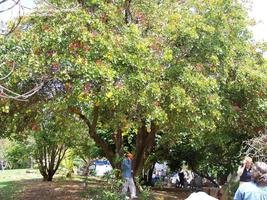
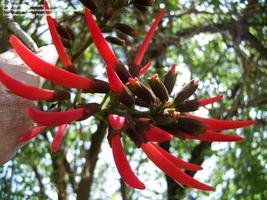 Erythrina lanceolata in southern California
Erythrina lanceolata in southern California
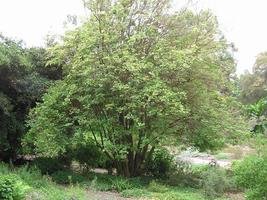
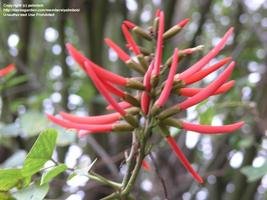 Erythrina atitlanensis in southern California
Erythrina atitlanensis in southern California
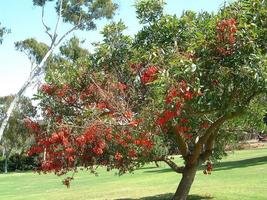
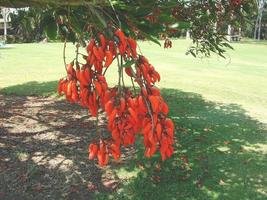
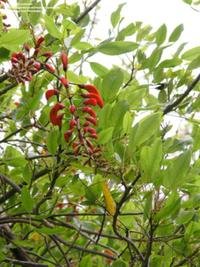
Erythrina falcata in southern California (first two photos RWhiz)
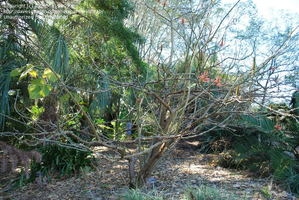
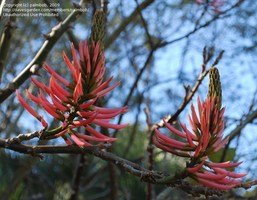
Erythrina speciosa in southern California (pink flowering cultivar)
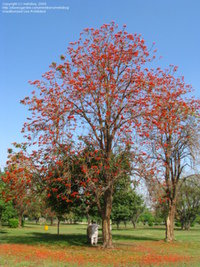
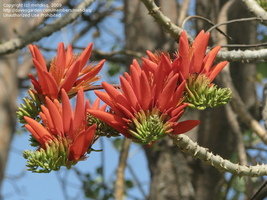 Erythrina suberosa in Pakistan (photos by mehdisq)
Erythrina suberosa in Pakistan (photos by mehdisq)
Copyright © www.100flowers.win Botanic Garden All Rights Reserved